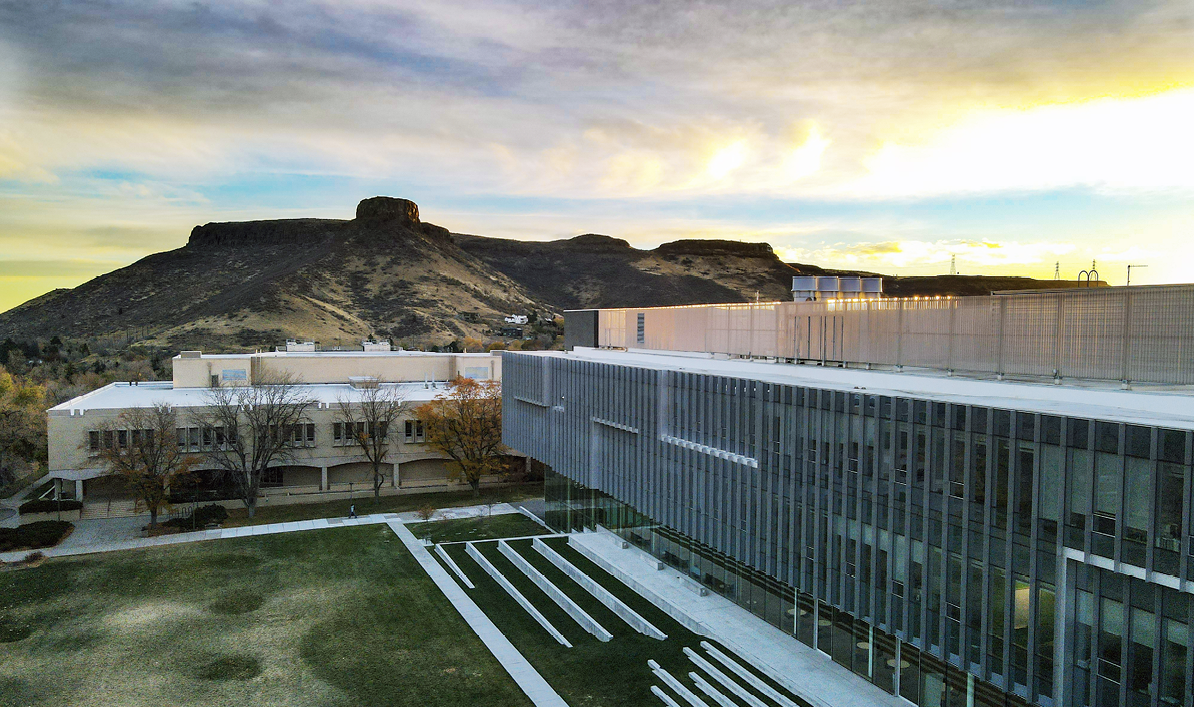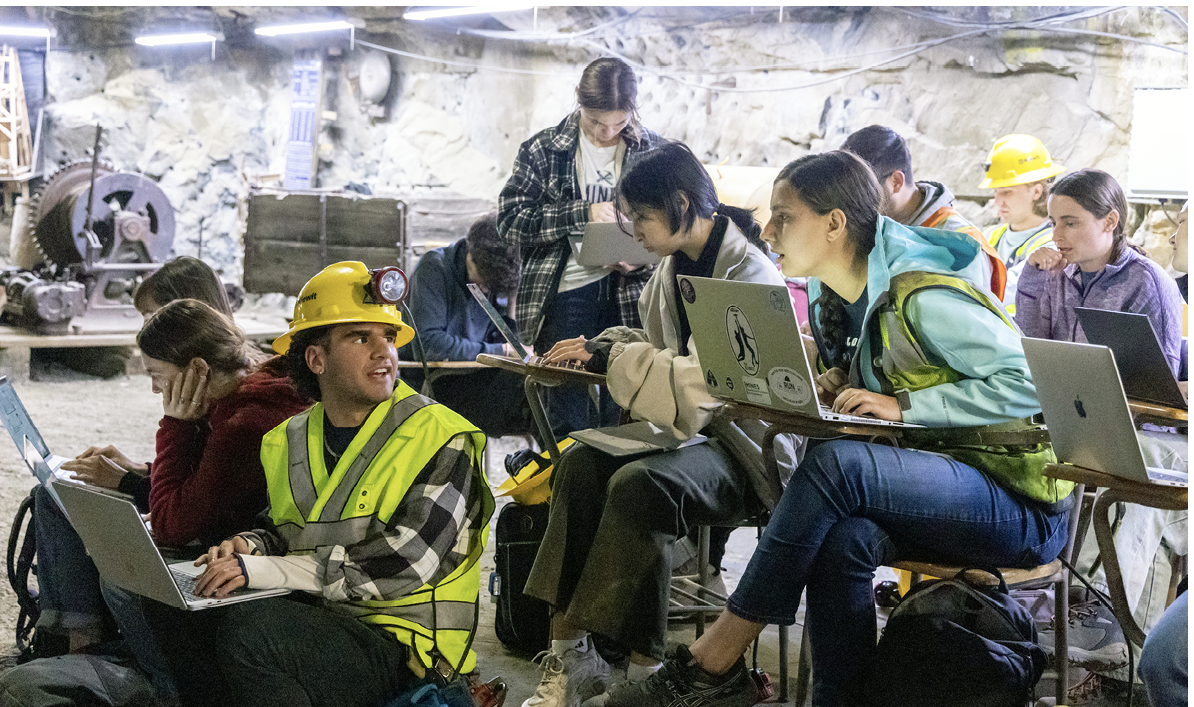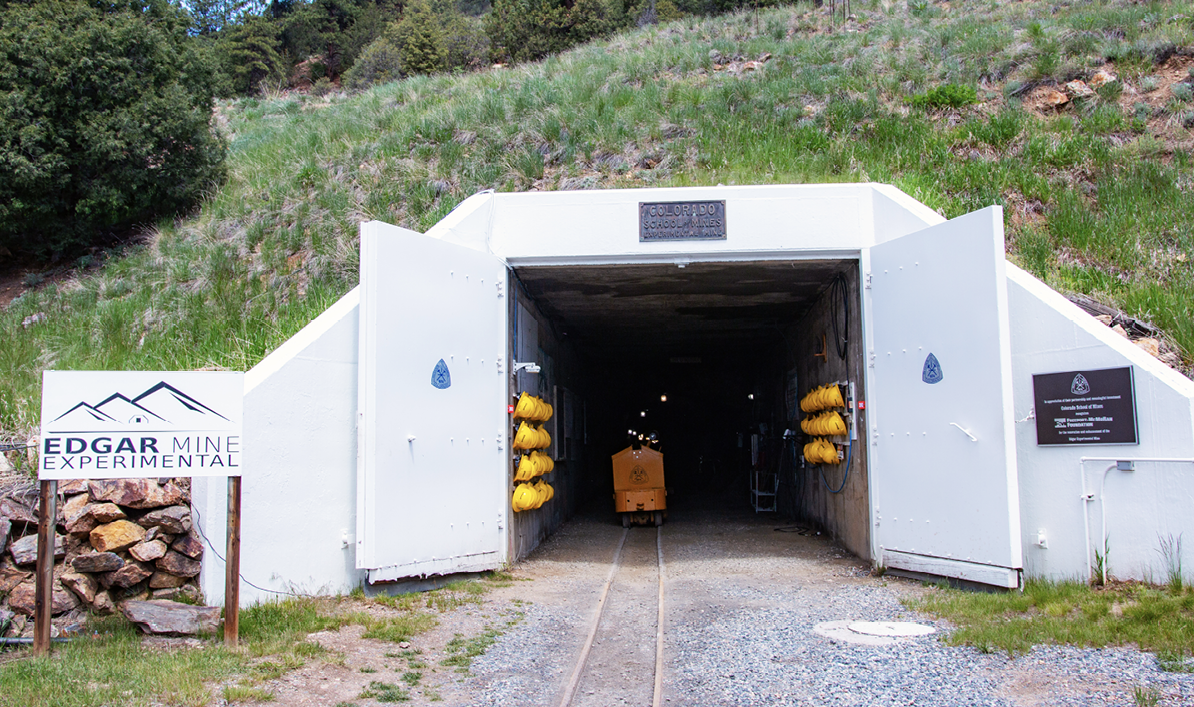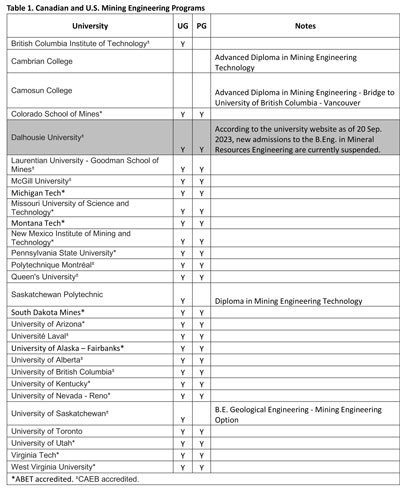North American Mining discusses the current state and future development of mining education in North America with experts from some of the region’s leading mining engineering schools, the National Mining Association, and the Mining Industry Human Resources Council.
by Jonathan Rowland

Photo: Colorado School of Mines
Workforce and talent gaps are nothing new to anyone who has spent time around the mining industry. The Society of Mining, Metallurgy & Exploration (SME) was arguing back in 2014 that workforce availability had become a significant problem for the U.S. mining industry (Workforce Trends in the Mining Industry, SME, 2014) with more than half of the then-current workforce, some 221,000 workers, expected to be retired by 2029.
Ten years on and the same issues remain but have been joined by some new challenges. The skills needed to work in the industry are expanding, as new technologies transform the way the industry works and as deeper, lower quality, and more complex orebodies are exploited. Mining is also under pressure to reduce its environmental footprint in line with net zero ambitions. Social license to operate and governance concerns have similarly risen as potential risk factors to mining businesses.
At the same time, access to critical metals and minerals has also become a major political and economic talking point. As M. Stephen Enders, Mining Engineering Department head and professor of practice at Colorado School of Mines, succinctly put it: “the world needs more minerals and metals to support a growing population, the energy transition, and electrification.” And a consequence, it needs “far more young people to enter the industry.”
Critical education for a critical challenge
“The U.S. is home to vast mineral reserves,” said Ashley Burke, senior vice president, Communication, at the National Mining Association (NMA). “But we need a ready workforce to access those minerals; without it, we will merely be looking overseas, bypassing high-paying American jobs, and yielding our economic security to geopolitical rivals.”
It is thus “immensely important” to have a good mining education sector in North America, agreed Barbara J. Arnold, chair and professor of practice in Mining Engineering at the John and Willie Leone Family Department of Energy and Mineral Engineering at the Pennsylvania State University (Penn State). “We need to onshore as much production of critical metals and minerals as possible, so we are not held hostage by other countries for our supplies.”
Similar themes were also noted north of the border by Ryan Montpellier, executive director of the Mining Industry Human Resources Council (MiHR), which brings together mining companies, organized labor, contractors, educational institutions, industry associations, and Indigenous groups to address human resource and labor market challenges. “To support expansion and avoid labor shortages, Canada’s mining sector needs a robust pipeline of qualified and skilled workers. Thus, a well-functioning post-secondary education system is vital for the sustainable growth of the industry in the coming decades.”
“But the role of colleges and universities extends beyond enrolments and graduation statistics,” Montpellier continued. “Support mechanisms, such as career services and support, field trips, guest lectures, research partnerships with industry, and work-integrated learning opportunities, help students navigate challenges and embrace opportunities within the mining industry. These programs are vital to a strong mining education sector and ultimately to an inclusive, skilled and sustainable mining workforce.”

Not a pretty picture
Unfortunately, the picture is not positive. There are currently 14 ABET-accredited mining programs at universities in the U.S., down from 25 in 1982. “Collectively, we graduate about 185 students per year into a domestic demand of 500,” noted Colorado School of Mines’ Enders. “We have also experienced an average 40% drop in enrollment in our undergraduate programs since 2015.”
This is in “stark contrast” to other regions, added Ashley Burke of the NMA. For example, there are over 38 mineral processing schools and upwards of 44 mining engineering programs in China. Central South University, the country’s largest mineral processing program, has 1,000 undergraduates and 500 graduate students alone, who are “ready to accomplish China’s mineral ambitions.”
“We know there is a huge gap between the workforce we have and the one we need for the future,” concluded Burke. “Vastly more focus is thus needed on educating, training, and preparing the next generation of miners.”
“The North American mining industry and, by extension, mining education is at a critical juncture,” agreed Aaron Noble, professor and department head of Mining and Minerals Engineering at Virginia Tech. “Increased societal focus on sustainably-sourced minerals, combined with changing material needs associated with the clean energy transition, have brought elevated attention and intense pressure to the mining sector.
At the same time, macroscale issues facing higher education, as well as reduced enrollments in mining engineering departments, are creating a looming workforce shortage.”
The situation was summed up by MiHR’s Ryan Montpellier. “It’s imperative that the next generation of workers are inspired to pursue mining careers and enroll in mining education. Yet mining programs are small, shrinking, unresponsive to labor demand, geographically concentrated, threatened by capacity issues, and struggling with diversity.”
An image problem
Among these other challenges, mining also continues to suffer from ignorance: prospective students are often not aware of the what the sector does and how it has changed from the unsafe and dirty industry of the past.
“Most undergraduates don’t know where materials and metals come from, what mining is, or they have a bad perception of the industry,” explained Scott Dunbar, professor in the University of British Columbia’s (UBC) Department of Mining Engineering. “If they don’t know what it is, it’s impossible for them to form an opinion about whether to enroll in a mining program. Also bad perceptions of the industry are impossible to change. Mining departments are thus struggling to attract undergraduate students.”
“Mining education has always suffered from low enrollment and high variability in student interest. Students are not consistently attracted to the profession,” agreed Julian Ortiz Cabrera, associate professor and department head at the Robert M. Buchan Department of Mining at Queen’s University. “They do not see mining as a complex, high-technology industry. This is coupled with the lingering reputation that mining is anti-ecological.”
The education sector “cannot solve this challenge on our own,” explained Penn State’s Arnold. “Everyone in the industry needs to step up and talk about mining. Instead, we hide our mines and processing plants. We reclaim mined land so well that people don’t realize that, for example, the Boy Scout Jamboree site in West Virginia is a reclaimed mine site. But good news stories like this needs to be told!”
At Colorado School of Mines, “we are trying to enlighten students and prospective students about the outstanding career opportunities in the mining sector, as well as how it differs from the mining industry of the past. We also want them to understand how they can be involved in transforming the industry and help to solve some of the world’s great challenges,” said Enders.
But again, assistance is needed from others with a stake in the future of the mining workforce, as Enders continued: “We need financial support from government, industry, and private individuals to increase the number and value of scholarships available for students, and we need these scholarships to be prestigious to attract more students.
Queen’s University is also working to change poor perception of the industry by “positioning mining education as a way to create stewards of the environment, who extract materials necessary for society to function with the least possible impact, explained Ortiz Cabrera. “We are trying to communicate that mining is needed and that we cannot maintain our society without the continuous extraction of raw materials.”

Photo: Colorado School of Mines
Changing industry; changing curricula
The Ontario-based institution is also developing new technology to support the needs of the industry and changing how it educates future mining engineers. This includes the use of virtual reality to introduce students to operations; innovating with hybrid-learning theory and practical educational models; and creating bridging programs that support student transition from college to university. And it points to another challenge facing the mining education sector: the changing nature of the industry itself.
“The skills needed to be a successful mining engineer are expanding,” explained Virginia Tech’s Noble. “Mine design, planning, and permitting are becoming increasingly complex, while the integration of automation, data analytics, AI, and other tools requires a broader knowledge and skills base. Moreover, mining faces increased social, legal, financial, and environmental constraints that mining engineering graduates must understand. At the same time, most universities are under pressure to reduce the credit hour requirements and reduce overall program costs, which means we have fewer instructional hours to cover an increasing amount of content.”
Queen’s University professor Ortiz Cabrera echoed these concerns: “The challenge is to resource the growing range and technological sophistication of tools needed for mining engineers. Our students need to learn more than ever: not only fundamentals but also robotics, AI, cutting-edge technologies and processes. Furthermore, our graduates need to be competent to communicate with communities with different cultural backgrounds and build a positive environment around mining projects.”
“Our students need to know the fundamentals of science, technology, engineering and math, and develop skills in critical thinking, teamwork, and problem solving, among others,” agreed Colorado School of Mines’ Enders. “They also need to develop skills in computer programming, data analytics, AR/VR, robotics, automation, and reclamation and closure. And they need a solid understanding of business and economics, management and leadership, and the ESG aspects of the mineral resource industry. This is a tall task!”
Virginia Tech is addressing these issues through “a multi-faceted strategy that considers our industry’s needs, our department’s strengths, and the constraints and opportunities unique to our institution,” continued Noble. One example of this is the offering of free electives on hot topics, including space mining, mining automation, and data analytics, to engineering freshman students, who don’t have enough standard courses to fill their schedule. “These courses are very popular and allow new students to learn about our industry, participate in hands-on activities, and interact with our faculty. These interactions increase their awareness and interest, and many enrolled in those courses end up choosing to pursue a degree in mining engineering.”
Curricula are also changing to become more reflective of the challenges facing the industry today. “I now teach a sophomore-level class called ‘Leadership for Responsible Mining’, where we discuss the sustainability practices and business leadership principles needed to ensure mining is done in an environmentally and socially responsible manner,” noted the Virginia Tech educator. “A colleague also teaches a graduate class that was recognized by the UN Sustainable Development Solutions Network.”
“I want our field to be the destination for talent, where the best and brightest choose to seek the opportunities we can provide,” concluded Noble. “I believe the curriculum must maintain the standard of rigor that our industry demands, but at the same time we must meet all students where they are and provide the resources and tools to be effective. We must continuously adapt our educational practices and areas of emphasis, but I do believe a robust blend of traditional classroom instruction, experiential learning, field work, and career bridge experiences are needed to attain the best outcomes.”
“How we teach engineers is evolving,” agreed Ortiz Cabrera. “We are moving toward problem-based and experiential learning that introduces students to grand challenges through their educational journey. We are also becoming better integrated with social sciences and humanities to allow students to grow in their understanding of the total impact of engineering projects. And we are adopting more competency-based models for assessment to ensure our students have mastery of these subjects. In aggregate, we are graduating students that are more than just technically skilled, but globally minded and able to adapt a project-based approach to any problem they are confronted with.”
Educating for the 21st century
These trends are not unique to Virginia Tech but can be seen across the mining education sector.
In Ontario, Queen’s University is “upgrading our curriculum at undergraduate and graduate levels to ensure our students have the skills needed by today’s modern, highly technological, and social integrated mining industry, enabling them to become leaders in technology, management, and policy making for the mining industry,” explained Ortiz Cabrera. “We envision first year students will have access to career readiness training, experiential learning projects, industry guides, and AI tools to prepare them for professional practice in third and fourth year. We will curate societal and engineering challenges that build clear connections between classroom and workplace, while our internship and experiential opportunities will focus increasingly on the UN’s 17 Sustainable Development Goals.”
Penn State has also embraced new topics and modes of working. “We offer several technical electives, including ones of automation and control, and responsible mining,” noted Arnold. “And we are rolling up our sleeves and teaching some of the department’s general education courses that have more than 1,000 students in web-based sections. We are exploring more international collaboration to bring qualified graduate students to Penn State from around the world; and we are expanding our offerings and hope to soon start a mineral processing minor.”
UBC’s Dunbar provided a more cautious view, however: “Redesigning engineering programs to incorporate breadth and attract more students may risk problems with accreditation. As an alternative, a university could offer an unaccredited degree with sufficient engineering content to allow graduates to work in the industry and, if necessary, obtain professional registration by means of additional courses and training. An interdisciplinary degree program with different electives could be another possibility; it would attract students and would provide useful, well-rounded graduates for the industry.”

What does the future hold?
“Mining needs to stop hiding in plain sight,” concluded Enders. “Everything in our built world has come from minerals or metals, or it had to be harvested, processed, or manufactured using tools and equipment made from minerals or metals. We need everyone in the world to know how essential this is. And we need the next generation of students to lead the way in making this sustainable and socially acceptable.”
These thoughts were echoed by Arnold of Penn State: “I don’t want to be cliché, but we need to stop preaching to the choir. We need to get the word out to the public, either through grassroots campaigns or through targeted advertising. The industry is high tech. The supply chain starts with mining and mineral processing. These are high paying and varied jobs. The industry focuses on the health and safety of its workers and the communities in which it operates. These are good messages that we should be proud of.”
Arnold also pointed out the need for more focus on mineral and metallurgical processing. “We can mine as much as we like but, without also strengthening our mineral and metallurgical processing capacity, we’ll have to ship it to other countries for processing. We therefore need to grow our own mineral processing engineers and metallurgists. This specialty has, perhaps, dwindled more than mining engineering in the U.S. Fortunately, we have gained two new tenure-track mineral processing faculty at Penn State. We just need students to teach!”
Mining engineering education in the future “will have to adapt to changes in student interests and goals, changes in modes of university education, changes in technologies used by the mineral resources industry, changes in public perception of the mineral resources industry, changes in the relationship society has with metals and materials, changes in the regulatory landscape, and changes in business models used by industry to produce useful materials and create value,” concluded UBC’s Dunbar. “In short, it will have to be, and be perceived as, many things to all people.”
Supporting the future
If universities are at the coal face of mining education development, the associations we spoke to also have a key supporting role to play. The NMA, for example, is working with Congress to support legislation such as the Mining Schools Act of 2023, which was introduced by Senate Energy and Natural Resources Committee Ranking Member John Barrasso (R-Wyo.) and Chairman Joe Manchin (D-W.Va.). The act would bolster domestic mining education and training, and require the Department of Energy, in consultation with the Department of the Interior, to provide technology grants to enhance mining education and sustain the positive outlook for mining professionals.
At the same time, the association is also working to educate the next generation about jobs, promoting a series of videos on careers in mining that focuses on the wide range of high-paying opportunities the mining industry offers.
In Canada, MiHR leads collaboration between education and industry to align education with industry needs. It also offers a range of programs that provide financial support for those considering a career in mining, including wage subsidies for work placements and scholarships for those in post-secondary mining-related education programs. And it runs the Canadian Mining Training Recognition Program, which recognizes mine training programs delivered by employers, educational institutions, and training organizations that align with MiHR’s National Occupational Training Standards (NOTS). The NOTS provide the learning objectives and outcomes that guide quality training, curriculum design and development.
A huge opportunity
“The pressure to supply the world with vast amounts of raw materials it needs creates a huge opportunity for mining education,” concluded Ortiz Cabrera. After years of declining enrollments, could now be the time for some positive change? All those involved in the industry should certainly hope so.
Editor’s note: We thank all of the above universities for contributing to this report. Want to share input for your mining engineering program? Email the editor at [email protected] as we continue the converation on this important issue.
